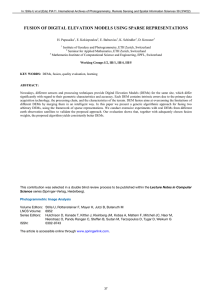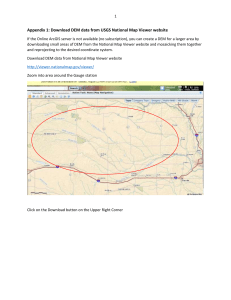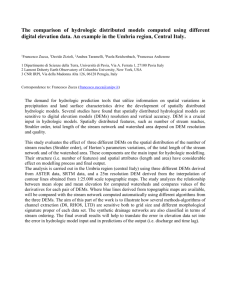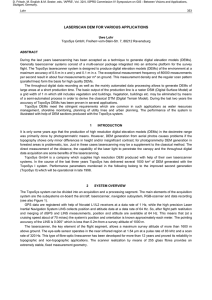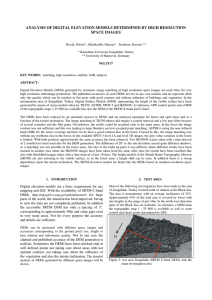ACCURACY AND MORPHOLOGICAL ANALYSES OF GTOPO30 AND SRTM X –
advertisement
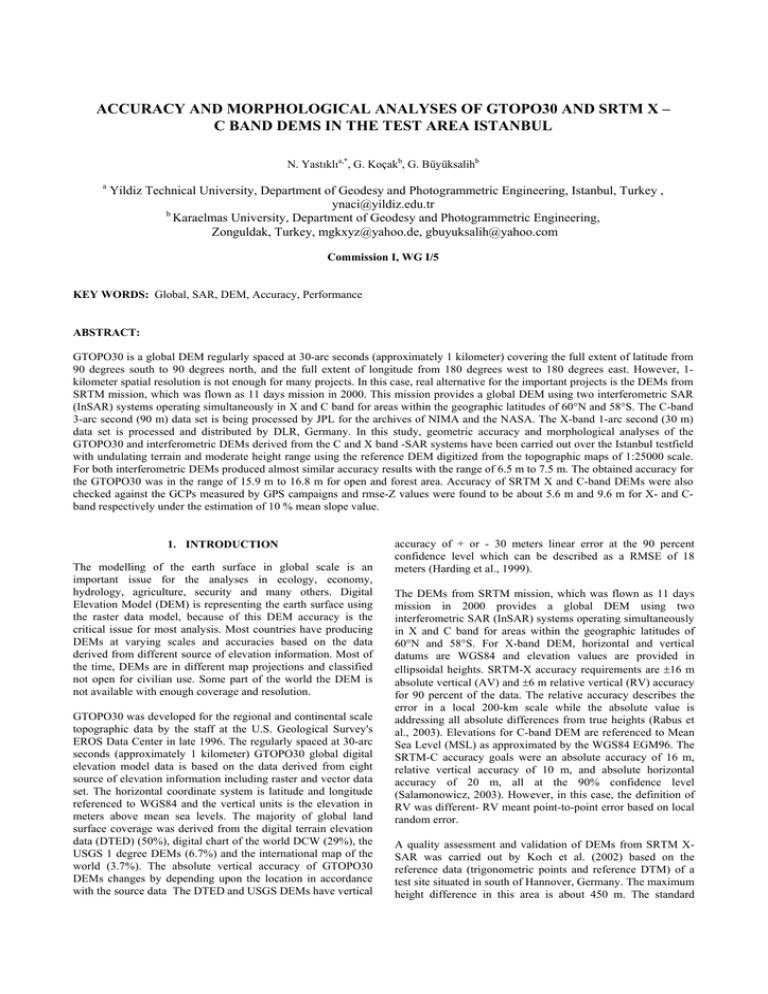
ACCURACY AND MORPHOLOGICAL ANALYSES OF GTOPO30 AND SRTM X – C BAND DEMS IN THE TEST AREA ISTANBUL N. Yastıklıa,*, G. Koçakb, G. Büyüksalihb a Yildiz Technical University, Department of Geodesy and Photogrammetric Engineering, Istanbul, Turkey , ynaci@yildiz.edu.tr b Karaelmas University, Department of Geodesy and Photogrammetric Engineering, Zonguldak, Turkey, mgkxyz@yahoo.de, gbuyuksalih@yahoo.com Commission I, WG I/5 KEY WORDS: Global, SAR, DEM, Accuracy, Performance ABSTRACT: GTOPO30 is a global DEM regularly spaced at 30-arc seconds (approximately 1 kilometer) covering the full extent of latitude from 90 degrees south to 90 degrees north, and the full extent of longitude from 180 degrees west to 180 degrees east. However, 1kilometer spatial resolution is not enough for many projects. In this case, real alternative for the important projects is the DEMs from SRTM mission, which was flown as 11 days mission in 2000. This mission provides a global DEM using two interferometric SAR (InSAR) systems operating simultaneously in X and C band for areas within the geographic latitudes of 60°N and 58°S. The C-band 3-arc second (90 m) data set is being processed by JPL for the archives of NIMA and the NASA. The X-band 1-arc second (30 m) data set is processed and distributed by DLR, Germany. In this study, geometric accuracy and morphological analyses of the GTOPO30 and interferometric DEMs derived from the C and X band -SAR systems have been carried out over the Istanbul testfield with undulating terrain and moderate height range using the reference DEM digitized from the topographic maps of 1:25000 scale. For both interferometric DEMs produced almost similar accuracy results with the range of 6.5 m to 7.5 m. The obtained accuracy for the GTOPO30 was in the range of 15.9 m to 16.8 m for open and forest area. Accuracy of SRTM X and C-band DEMs were also checked against the GCPs measured by GPS campaigns and rmse-Z values were found to be about 5.6 m and 9.6 m for X- and Cband respectively under the estimation of 10 % mean slope value. 1. INTRODUCTION The modelling of the earth surface in global scale is an important issue for the analyses in ecology, economy, hydrology, agriculture, security and many others. Digital Elevation Model (DEM) is representing the earth surface using the raster data model, because of this DEM accuracy is the critical issue for most analysis. Most countries have producing DEMs at varying scales and accuracies based on the data derived from different source of elevation information. Most of the time, DEMs are in different map projections and classified not open for civilian use. Some part of the world the DEM is not available with enough coverage and resolution. GTOPO30 was developed for the regional and continental scale topographic data by the staff at the U.S. Geological Survey's EROS Data Center in late 1996. The regularly spaced at 30-arc seconds (approximately 1 kilometer) GTOPO30 global digital elevation model data is based on the data derived from eight source of elevation information including raster and vector data set. The horizontal coordinate system is latitude and longitude referenced to WGS84 and the vertical units is the elevation in meters above mean sea levels. The majority of global land surface coverage was derived from the digital terrain elevation data (DTED) (50%), digital chart of the world DCW (29%), the USGS 1 degree DEMs (6.7%) and the international map of the world (3.7%). The absolute vertical accuracy of GTOPO30 DEMs changes by depending upon the location in accordance with the source data The DTED and USGS DEMs have vertical accuracy of + or - 30 meters linear error at the 90 percent confidence level which can be described as a RMSE of 18 meters (Harding et al., 1999). The DEMs from SRTM mission, which was flown as 11 days mission in 2000 provides a global DEM using two interferometric SAR (InSAR) systems operating simultaneously in X and C band for areas within the geographic latitudes of 60°N and 58°S. For X-band DEM, horizontal and vertical datums are WGS84 and elevation values are provided in ellipsoidal heights. SRTM-X accuracy requirements are ±16 m absolute vertical (AV) and ±6 m relative vertical (RV) accuracy for 90 percent of the data. The relative accuracy describes the error in a local 200-km scale while the absolute value is addressing all absolute differences from true heights (Rabus et al., 2003). Elevations for C-band DEM are referenced to Mean Sea Level (MSL) as approximated by the WGS84 EGM96. The SRTM-C accuracy goals were an absolute accuracy of 16 m, relative vertical accuracy of 10 m, and absolute horizontal accuracy of 20 m, all at the 90% confidence level (Salamonowicz, 2003). However, in this case, the definition of RV was different- RV meant point-to-point error based on local random error. A quality assessment and validation of DEMs from SRTM XSAR was carried out by Koch et al. (2002) based on the reference data (trigonometric points and reference DTM) of a test site situated in south of Hannover, Germany. The maximum height difference in this area is about 450 m. The standard deviation of SRTM DTED-2 was found to be ±3.3 m in open landscape using spatial similarity transformation. Rosen et al. (2001) reported the RMS height error of DEM from SRTM Cband data on the order of 3 m using six fully mosaicked cells for the NIMA test sites. In Salamonowicz (2003), elevations from SRTM C-band DEM were compared to 8 ground truth datasets. Then the computed AV and RV were analyzed against the AV and RV as predicted by the SRTM data. Except the Guatemala and Panama sites, for which data used as truth are not error free, the obtained predicted and measured AV and RV values for other test sites agree well. In this case, measured AV and RV values stated at the 90% confidence level are in the range of 4.2-6.5 m and 5.6 to 8.3 m respectively, changing with the elevation variations and the vegetation types of test sites. In the separate study by Kocak et al., 2005 the accuracy assessments of the interferometric DEMs derived from the X and C-SAR systems over the mountainous Zonguldak testfield against the reference DEM digitized from the topographic maps of 1:25000 scales were analyzed. Obtained results for both interferometric DEMs show similarity and lie in the range of 10-11 m. In the same study, accuracy of SRTM X and C-band DEMs were also checked against the GCPs measured by differential GPS and rmse-Z values were found to be about 9 m which confirms the results obtained based on the reference DEM. In this study, accuracy assessments of GTOPO30 and DEMs from both SRTM X and C-band data were carried out over the Istanbul testfield which is bridging the two continents. In the Istanbul case, it is an undulating terrain with not very much height differences and covering different types of terrain objects i.e. built-up areas, forest, lakes, etc. Again, GTOPO30 and two interferometric DEMs were analyzed based on the reference DEM digitized from topographic maps of 1:25000 scale. The DEMs from both SRTM X and C-band data were analyzed based on the ground control points (GCPs) measured by the GPS-surveys. Obtained results are reported in detail following sections. Figure 1. SRTM X-and C band SAR system is historically limited to a 45 km wide swath resulting in coverage holes of ca. 150 km x 150 km size at equatorial regions. X and C-bands swath widths are illustrated in Figure 2 and the X-band coverage holes in the data take including the experimental test site of this paper are shown in Figure 3. Due to the avoidance of ScanSAR and the shorter wavelength, the quality of the X-band interferograms and DEMs is expected to be better than of those from C-band by a factor of 2 (Rabus et al., 2002). However, from a topographic structure viewpoint, the X and C-band data should contain very similar information. The X-band and C-band data are therefore of quite similar quality and can be productively compared in the regions of overlap (Rosen et al., 2001). 2. SRTM MISSION SRTM is a cooperative project of the National Aeronautics and Space Administration (NASA) and the National Imagery and Mapping Agency (NIMA) in the USA and the Deutches Zentrum für Luft and Raumfahrt (DLR) in Germany. The Italian space agency is cooperating with DLR by contributing flight hardware previously flown in 1994, and by participating in data processing. Two single-pass interferometers were built and operated in parallel in the mission, the US C-band system and a German/Italian X-band system X-SAR. The master channels (transmit and receive) of both interferometers used the original components in the shuttle cargo bay. The secondary (receive-only) antennas were mounted at the tip of a 60 m long lightweight mast (Figure 1). During lift-off and landing, the mast was stowed away in a 3 m long canister. Once in orbit, the mast was unfolded by a smart mechanical construction. The C-band radar with a wavelength of 5.6 cm has an electronically steerable antenna and is therefore able to operate in ScanSAR mode with a 225 km swath. Most of the mappable area was imaged two or more times from ascending and descending vantage points. However, the X-band radar system operated at 3 cm wavelength with its passive primary antenna Figure 2. Swath widths of C-band and X-band Figure 3. X-band coverage with in Istanbul testfield The SRTM X-SAR processing system was developed by DLR based on experience from the 1994 SIR-C/X-SAR mission (Bamler et al., 1993) and from ERS Tandem interferometric processing (Schaettler et al., 1999). Generation of DEMs from interferometric SAR data includes processing and the geocoding part. In processing part the digital signal processing problems are handled. The geocoding and the mosaicking parts deal with transformation from sensor domain to map coordinate space in addition to the regridding and fusion of data (Roth et al., 1999). Final DEM mosaic is split into the tiles with the dimensions of 15′ length both in latitude and longitude (approximately 30 km) and transformed into the DTED format. Additionally a Height Error Map (HEM) is available. HEM is co-registered to the DEM and describes the relative accuracy of each pixel. The accuracy determination procedure is described in Knöpfle et al. (1998). All X-SAR data except data over Italy are processed, archived and distributed at 1 arcsec spatial resolution by the German Remote Sensing Data Center (DFD) of DLR. The processing of the SRTM C-band data was done by the Ground Processing System (GDPS) developed by JPL. The GDPS had two major subsystems, the Topography Processing Subsystem (TPS) and the Mosaic Processing Subsystem (MPS). The TPS performed the initial processing of the strips. In this step, interferometric techniques are used to generate terrain heights in a quasi-grid pattern in a local coordinate system at a density greater than the final 1 arcsec post spacing. These heights are then combined using a simplicial regridding scheme. A final adaptive filter was applied to reduce noise. The MPS combined the posts from the ascending and the descending strips. This step was accomplished in a large continental scale least squares adjustment, simultaneously removing systematic effects and producing elevation map products in DTED-2 format. The final finishing step involves water body editing and other post inspection and editing processes, and computation of final accuracy values. One arcsec data over the US is freely available, as is 3 arcsec data over the world. NIMA is presently restricting access to 1 arcsec data outside the US, but investigators can make special requests through NASA. 3. THE TEST FIELD AND REFERANCE DATASETS The test site Istanbul and its close vicinity (29° East, 41°North) is located where the two continents (Europe and Asia) are bridging (Figure 4). This testfield occupies an area of approximately 6000 square km and includes partly built up area, especially in the alongside of the Bosporus and Marmara Sea coast and there are some agricultural lands in the inner regions of both European and Asian side. The forested site is located in the north of testfield and along the Black Sea coast. There are two natural lakes and four artificial lakes (dam lakes) available in the testfield. Elevation ranges up to 537 m with the mean height of 112 m and the average inclination is in the range of 10 %. As a reference, DEM based on contour lines with 10m intervals digitized from the topographic maps of 1:25000 scale is available. Apart from this, more than 8000 ground control points measured by GPS campaigns with the accuracy of better than 50 cm for all coordinate components. Figure 5 shows the greyvalue-coded form of reference DEM at the background and the GPS points as white dots on the foreground. Figure 4. Istanbul testfield Figure 5. Grey value coded form of reference DEM of Istanbul testfield and GPS points In the meantime, accuracy of reference DEM was assessed using GPS points and the RMS error in height was found to be 4.12 m. It can also be expressed a function of the slope with an equation of rmse-Z = 2.57 + 22.67 * tan (slope). Thus, in flat areas, the reference DEM has an accuracy of about 2.6 m and at the average inclination of 10% it will be in the range of 4-5 m. Approximately, 30 % of the testfield is covered by not a very dense forest which can be seen in the Figure 6 with light gray color. This is a result of image classification, carried out based on the Landsat TM scene of area. The forest areas is important for this test because the reference DEM corresponds directly to the surface while the SRTM DEMs refer to the visible surface of the vegetation and to the roofs of buildings. Figure 8. SRTM X-band DEM with grid spacing of 1 arcsec Figure 9. SRTM C-band DEM with grid spacing of 3 arcsec Figure 6. Forest area cover in Istanbul testfield shown by light gray color 3.1 GTOPO30 and DEMs from SRTM X and C-band data Figures 7, 8 and 9 show respectively the coverage of GTOPO30, X- and C-band DEMs of the Istanbul testfield in gray value coded form. Together with the X band DEM, the DLR is distributing so called a Height Error Map (HEM) with the estimated individual point accuracy. For the C-band, there is no height error map available. The C-band has the advantage of a large swath width, so most parts are covered at least twice from different directions solving very often the problems of layover and shadow. From the analysis of HEM data, average standard deviation was found to be 8.67 m with the peak errors in the range of 90 m to 180 m located along the Bosporus, coastline and lakes. Such a situation shows the problems of the InSAR. In steep areas SRTM is experiencing layover and shadow. Figure 7. GTOPO30 DEM with grid spacing of 30 arc seconds The SRTM DTED-2 data represent the surface including vegetation and buildings especially in the short-wave X-band. Thus, the dataset is a digital surface model in contrast to the reference DEM. The data are given in ellipsoidal coordinates referring to the geocentric ellipsoid WGS84. For comparison, DTED-2 data were transformed into the coordinate system of the reference DEM. A datum transformation between the ellipsoids WGS84 and Hayford was carried out, additionally the ellipsoidal heights were corrected using geoid undulations. After these transformation steps the DTED-2 data are approximately distributed in a rectangular grid. Grid spacing in north-south direction is about 30 m and 90 m for X and C-band data, the grid spacing in east-west direction depends on the ellipsoidal latitude. The test area is situated at latitude of about 41 degrees. Therefore the grid spacing in east-west direction is about 23 m and 68 m for each case. 4. ACCURACY AND MORPHOLOGICAL ANALYSES OF GTOPO30, SRTM X AND C BAND DEMS For the geometric accuracy checks, GTOPO30 and interferometric DEMs from SRTM X and C-band SAR were compared with reference DEM digitized from 1:25000 scaled maps. The accuracy of the DEMs from SRTM X and C-band SAR were also checked against the control points from GPS measurements. The obtained results are summarized in Table 1. To respect the forest layer, analyses have also been done for the areas with forest and without forest in addition to the whole area. Based on the comparison with the GPS points, it can be seen that the SRTM X-band gave more accurate results against the C-band. However, with deeper analysis, especially on the slope depending components, while C-band produced better results in the flat areas, with the increase in the slope value, influence of C-band grid interval becomes more prominent. Reference GPS points DEM DEMs Type of area RMS Z Bias SRTM-X All 5.57 -2.61 RMS without bias 4.92 SRTM-C All 6.47 -1.57 6.28 SRTM-X All 7.15 -0.12 7.15 SRTM-X Open 7.00 -0.82 6.95 SRTM-X Forest 7.50 1.98 7.24 SRTM-C All 6.81 -1.23 6.70 SRTM-C Open 6.52 -1.01 6.44 SRTM-C Forest 7.12 -1.33 6.99 GTOPO30 All 17.17 4.89 16.46 GTOPO30 Open 16.76 5.46 15.85 GTOPO30 Forest 17.27 4.12 16.78 Standard deviation of height at slope tan α α 4.06 + 55.156 * tan α 5.17 + 10.928 * tan α 4.92 + 10.464 * tan α 5.95 + 12.038 * tan α 5.03 + 20.427 * tan α 5.02 + 18.422 * tan α 5.25 + 21.073 * tan α 13.82 + 48.528 * tan α 13.42 + 53.615 * tan α 13.01 + 52.083 * tan α 4.56 + 10.496 * tan Table 1. Discrepancies between reference data and DEMs The comparison with the reference DEM yielded almost same level accuracy for both SRTM DEMs. Based on the separate analysis, X-band produced 7.0m and 7.2m rmse values for the open and forest areas respectively. In the case of forest areas, 2.0m systematic shift was obtained. Such a shift is the effect of forests and is also visible in asymmetric shift of the frequency distribution, which shows biased normally distributed pattern. The close inspection of frequency distribution of height differences between SRTM DEMs and the reference DEM, limit for DZ values can be taken as 100 m in all computations. For the C-band, the gap between the accuracy levels of open and forest areas are somewhat widened and 6.4m and 7.0m rmse values were acquired for the open and forested areas respectively. Such a trend can also be seen from the results of X-band. The obtained accuracy level for GTOPO30 was 15.9 m and 16.8 m for open and forest areas. The GTOPO30 systematic shift values were in the range of 4.1 m - 5.5 m. For morphological analyses purpose, same profile was taken along the each DEM and compared accordingly in the Figure 10. As can be seen from this Figure 10, X-band DEM with smaller grid interval has given more details against the reference and SRTM C-band DEMs which have 50m and 80m grid spacing respectively. Figure also showed that the larger the grid interval, smoother the DEM data and the terrain characteristics. Same result can be reached clearly by the analysis of Figure 11, which is showing the morphological details for a small part from Istanbul testfield by drawing the contour lines. Looking at the grid intervals, one can expect that the X-band (30m) should give more accurate results against the C-band (80m). However, situation is not in line with the expectations. The reason for this can be lie in the fact that the reference DEM has almost similar accuracy level with the interferometric DEMs. So, reference DEM is also contributes itself the rmse height values obtained for the SRTM DEMs. However, for the Istanbul DEM, this is the reference material with the higher accuracy. Figure 10. Height profiles derived along the testfield using reference and interferometric DEMs Reference SRTM X band SRTM C band Figure 11. Contour representation for the same area from reference and Interferometric DEMs 5. CONCLUSION Users from a diverse range of communities have long sought a source of consistent, high-resolution data. SRTM is meeting and exceeding the expectations by providing a near-global set of elevation data at a high resolution that was collected in an 11-day period. In this study, the accuracies of GTOPO30 and interferometric DEMs resulted from X- and C-SAR systems available in the mission were assessed by comparing elevations obtained and interpolated from digitized contours appearing on 1:25000 scaled topographic maps, which although expedient is not ideal. Accuracies were determined for both open and forested areas for GTOPO30 and SRTM DEMs for each band. The GTOPO30 results were in the range of 15.9 m to 16.8 m for open and forest area. For SRTM DEMs, findings were quite similar to each other and in the range of 6.4 m -7.2 m. However, the reference DEM itself is not free of error. For this reason the interferometric DEMs have been compared with GPS-surveyed GCPs and obtained rmse-Z values for X and C-band DEMs quite different. For X- band, it was in the range of 5.6 m, but for the C- band, it was found to be 9.6 m for the Istanbul test field with the mean slope 10 %. In the case of GPS surveyed points, influence of grid interval was shown clearly and with X-band DEM which has smaller grid spacing better results were obtained. Moreover, since GPS points are selected always in the nice location matching for generating the DEM is also quite better there, so with GPS data somewhat biased results can be expected. With regard to the morphological detail, Z-profile through the testfield using the height information and contour representation showed that X-band with the smaller grid size gave much more terrain characteristics than the others. ACKNOWLEDGEMENT The authors are grateful to Istanbul Metropolitan Municipality for Reference DEM and Istanbul Water Resource Management Administration for GPS dataset. Also special thanks to Dr. Karsten Jacobsen of IPI, University of Hannover for supplying the SRMT X- band data from DLR. REFERENCES Bamler R., Breit H., Steinbrecher U., Just D., 1993. Algorithms for X-SAR processing, Proceedings of the IEEE, IGARSS 4: 1589-1592. Harding H. J., Gesch D. B., CarabajalC. C., Luthcke S.B., 1999. Application Of The Shuttle Laser Altimeter In An Accuracy Assessment Of Gtopo30, A Global 1-Kilometer Digital Elevation Model, International Archives Of Photogrammetry And Remote Sensing Volume Xxxii-3/W14 5 pages Knöpfle W., Strunz G., Roth A., 1998. Mosaicking of Digital Elevation Models Derived by SAR Interferometry, International Archives of Photogrammetry and Remote Sensing 32(4): 306313. Kocak G., Buyuksalih G., Oruc M., 2005. Accuracy Assessment of Interferometric Digital Elevation Models Derived from the Shuttle Radar Topology Misson C-and CBand Data in Moderate Forest Cover, Optical Engineering, 44 (3):36201,(1-7). Koch A., Heipke C., Lohmann P., 2002. Analysis of SRTM DTM – Methodology and Practical Results, ISPRS Commission IV Symposium, Ottowa: 6 pages. Rabus B., Eineder M., Roth A., Bamler R., 2003. The Shuttle Radat Topography Mission – A New Class of Digital Elevation Models Acquired by Spaceborne Radar, ISPRS Journal of Photogrammetry and Remote Sensing, 57: 241-262 Rosen P., Hensley S., Gurrola E., Rogez F., Chan S., Martin J., Rodriguez E., 2001. SRTM C-Band Topographic Data: Quality Assessments and Calibration Activities, IEEE IGARSS, 2001: 3 pages. Roth A., Knöpfle W., Rabus B., Gebhard S., Scales D., 1999. GEMOS – A System for the Geocoding and Mosaicking of Interferometric Digital Elevation Models, IEEE, IGARSS 2: 1124-1127. Salamonowicz P., 2003. Accuracy Assessment of Elevation Data from the Shuttle Radar Topography Mission, Proceedings of the ASPRS 2003 Annual Conference, Anchorage, Alaska: 12 pages. Schaettler B., Eineder M., Knöpfle W., Hubig M., 1999. Operational Interferometric ERS Tandem Data Processing, CEOS SAR Calibration Workshop, ESA/CNES, Toulouse.
